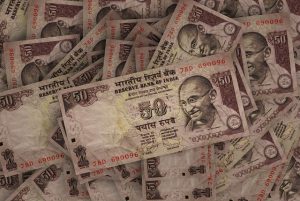The Indian economy is on the radar of most of the (Foreign Institutional Investors) FII’s across the globe. Let’s take a look at the ground realities of the Indian economy, by examining some of the macro-economic indicators. The Indian government has taken some very good steps
- To eradicate corruption through demonetization
- Increase revenue by reducing multiple taxation and the implementation of (Goods and Services Tax) GST;
At the same time , let us look at the effects of their implementation on the economy. Will investments in the right sectors jump start growth ?
Gross Domestic Product
GDP is the final value of all goods and services produced within a country for a financial year, an important indicator of the economic performance of a country. The Indian GDP is expected to grow at a rate of 6.5% during the current year ,while the latest numbers indicate a growth of 6.3%, a much lower number.
GDP is divided into 3 broad Sectors – Agriculture and Allied services, Industry and the Service sector.
Agriculture

Let us take a look at the Agriculture component of the GDP. India is primarily an agrarian economy (approx. 15% of the GDP is contributed by agriculture); and depends a lot on a good monsoon. There are many problems in the agriculture sector starting with
- Farmer suicides due to low productivity,
- Loss of crops through natural disasters
- Inability of farmers to repay money lenders
- Widening gap between the price realization by the farmer on one hand and the retail price paid by the consumer.
With the change in the global climate, it is essential to change the method of farming .The government has taken up several steps like introduction of drip and sprinkler irrigation which would ensure efficient utilization of water and improved productivity.
A good monsoon is also a pre-requisite for this sector. India had a normal monsoon in 2017; should there be a good monsoon in 2018 and the farmers have adequate finances at their disposal, an increase in consumption at moderate prices, would keep inflation of cash crops at bay. Banks would need to be cautious while disbursing loans; else these loans might end up as a (Non Performing Asset) NPA with the banks and then written off later.
In the latest budget the government has announced some plans to help farmers with access to funds. They are also taking steps to ensure better price realization to the farmer. With these steps there should be an improvement in the infrastructure of the agricultural sector , which would in turn lead to more jobs in the sector and a growth in the economy.
Industry

The second component of the GDP is Industry. Under the “Make in India” initiative, the Government of India aims to increase the share of the manufacturing sector in the gross domestic product (GDP) to 25 per cent by 2022, from 16 per cent, and to create 100 million new jobs by 2022. India is on the path of becoming a big hub for international manufacturing giants.
Trade balance
An announcement from the Ministry of Commerce and Industry states that taking merchandise and services together, the trade deficit for April – November 17-18 was estimated at US $ 60927.86 million. This is against the deficit of US $ 30095.19 million during April – November 2016-17. If the month of December 2017 is any indicator, export of merchandise during the month recorded a 12.4% YoY growth after 30.5% growth in November 2017. A lower growth in exports is noticed in labour intensive industries; exports of chemical products and engineering shipments rose marginally. On the other hand imports leaped by 22.8% MoM during December 2017. Oil and gold imports soared substantially during the period.
Inflation
With oil prices expected to rise by almost 25-30% over the next 2 years; inflation is expected to head northwards. Though the government estimates inflation to be at 4.2% during 2017 and 4.7% in 2018; further increase in the import of oil bill due to an increase in International oil prices, may act as a dampener to achieve the target. Government has a choice of reigning the inflation by reducing or removing the excise duty on Oil prices, albeit leading to the loss of revenue to the exchequer.
Implementation of GST
GST implementation was one of the largest technical implementation across the globe as the implementation involved a very large number of entities; in a very complex tax regime. The government needs to be applauded for this implementation which is aimed at the removal of multiple taxes and replacing them with single point taxation. This move introduces transparency in the entire system and improves tax collections. GST implementation has been mostly successful, but some more work needs to be done to achieve the GST target. The target includes resolution of problems in tax rates as well as applicability of the rules. Overall GST collections have not been close to the budgeted figures.
Demonetization and its effects

Demonetization, has to some extent contributed to problems with liquidity, which had adversely effected (Small and Medium Enterprises) SME and MSME organizations. SME’s employ close to 40% of India’s work force and contribute upto 45% of India’s manufacturing output. As a consequence of demonetization, many SME ad MSME units had to shut their business, which has also resulted in loss of jobs for a substantial number of people. The same amount of currency (which was removed from the system because of demonetization) is back in circulation. It will take a while before the financial system resumes the earlier pace of growth. Money with the banks seems to be good news, but adding fuel to the fire, a UN report has cautioned that public sector banks in India have bad loans which have been on the rise. If this is correct, despite the fact that the banks have funds, they would be wary of lending the money. This could result in slowing the growth of industries, fewer jobs and fewer exports. The economy might do well if the public sector banks disburse loans, but a bit cautiously, leading to increased production.
Exchange rates
The Rupee climbed 0.31% this calendar year following a 6% gain in 2017 resulting from record (Foreign Direct Investment)FDI flows. The global liquidity scenario and surging crude prices could put some pressure on emerging markets. However, increased flow of FDI in the future is likely to accelerate as India’s macro fundamentals show signs of improvement, a convincing reason for international companies to put cash into local fixed assets. Increased FDI inflow would keep pace with the extra requirement of dollars, expected to remain within a close range.
Investments Required
Growth of exports is a must for economic growth. For this, infrastructure has to be improved and capital investments acquired. Increasing Public and Private Investments is crucial to arresting India’s Economic growth slowdown. The government is already fighting this crisis, by disinvesting in state owned firms to garner funds. On the flip side, investments by the private sector has been at a low of 5.8% during the last year.
There are several reasons for low investments from the private sector.
- Demonetization
- Implementation of GST.
The low investment from the private sector is becoming a stumbling block to the development of the economy. Of course an increase in FDI is going to be a saviour, but with a caveat. It is possible , that an increase in the cost of production because of the high cost of funds might make exports non-competitive. If the India Story is to continue, we have to quickly get our house in order and deliver in line with the promises made by the government in the past; failing which foreign investors would not be there for long to invest in our economy.
Conclusion
It is clear that the growth in the economy is presently stalled and might take a downturn if not rectified in time. Continued growth in FDI coupled with investments from the domestic private sector would augur well for a jump start to the economy by creating an improved infrastructure and thus more jobs further leading to more production.





